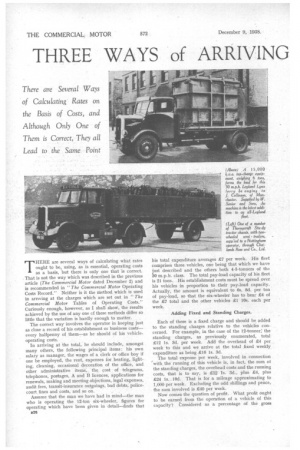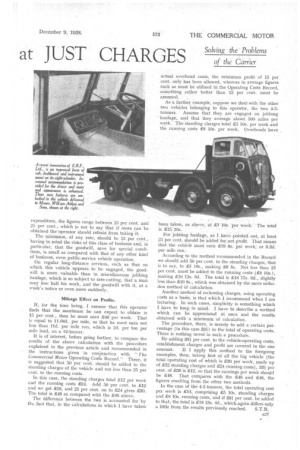THREE WAYS of ARRIVING
Page 40

Page 41

If you've noticed an error in this article please click here to report it so we can fix it.
at JUST CHARGES There are Several Ways of Calculating Rates on the Basis of Costs, and Although Only One of Them is Correct, They all Lead to the Same Point THERE are .several ways of calculating what rates ought to be,. using, as is essential, operating costs as a basis, but there is only one that is correct. . That is not the way which was described in the previous article (The Commercial Motor dated December 2) and is recommended in "The Commercial Motor Operating Costs Record." Neither is it the method which is used in arnving at the charges which are set out in "The Commercial Motor Tables of Operating Costs." Curiously enough, however, as I shall show, the results achieved by the use of any one cf these methods differ so little that the variation is hardly enough to matter.
The correct way involves the operator in keeping just as close a record of his establishment of business costs— every halfpenny of them—as he should of his vehicleoperating costs.
In arriving at the total, he should include, amongst many others, the following principal items : his own salary as manager, the wages of a clerk or office boy if one be employed, the rent, expenses for heating, lighting, cleaning, occasional decoration of the office, and other administrative items, the, cost of telegrams, telephones, postages, A and B licences, applications for renewals, making and meeting objections, legal expenses, audit fees, transit-insurance outgoings, bad debts, policecourt fines and costs, and so on.
Assume that the man we have had in mind—the man who is operating the 12-ton six-wheeler, figures for operating which have been given in detail—finds that a26
his total expenditure averages £7 per week. His fleet comprises three vehicles, one being that which we have just described and the others both 4-5-tonners of the 30 m.p.h. class. The total pay-load capacity of his fleet is 21 tons. His establishment costs must be spread over his vehicles in proportion to their pay-load capacity. Actually, the amount is equivalent to 6s. 8d. per ton of pay-load, so that the six-wheeler has to bear 24 of the 27 total and the other vehicles .61 10s. each per week.
Adding Fixed and Standing Charges.
Each of these is a fixed charge and should be added to the standing charges relative to the vehicles concerned. For example, in the case of the 12-tonner: the standing charges, as previously enumerated, total 212 is. 3d. per week. Add the overhead of 24 per week to this and we arrive at the total fixed weekly expenditure as being 216 Is. 3d.
The total expense per week, involved in connection 'with the running of this vehicle is, in fact, the sum ot the standing charges, the overhead costs and the running costs, that is to say, is 212 is. 3c1., plus 24, plus 224 Is. 10d. That is for a mileage approximating to 1,000 per week. Excluding the odd shillings and pence, the sum involved is 240 per week.
Now comes the question of profit. What profit ought to be earned from the operation of a vehicle of this capacity'? t onsidered as a percentage of the gross expenditure, the figures range between 15 per cent. and 25 per cent., which is not to say that if more can be obtained the operator should refrain from taking it.
The minimum, at any rate, should be 15 per cent., having in mind the risks of this class of business and, in particular, that the goodwill, save for special conditions, is small as compared with that of any other kind of business, even public-service vehicle operation.
On regular long-distance services, such as that on which this vehicle appears to be engaged, the good will is more valuable than in miscellaneous jobbing haulage, which is so subject to rate-cutting, that a man may lose half his work, and the goodwill with it, at a week's notice or even more suddenly.
Mileage Effect on Profits.
H, for the time being, I assume that this operator finds that the maximum he can expect to obtain is 15 per cent., then he must earn 246 per week. That is equal to 11.04d. per mile, so that he must earn not less than lid, per mile run, which is 2d. per ton per mile lead, on a 12-tonner.
It is of interest, before going farther, to compare the results of the above calculation with the procedure explained in the previous article and recommended in the instructions given in conjunction with " The Commercial Motor Operating Costs Record." There, it is suggested that 50 per cent. should be added to the standing charges of the vehicle and not less than 25 per cent. to the running costs.
In this case, the standing charges total £12 per week and the running costs £24. Add 50 per cent. to £12 and we get £18, and 25 per cent. on to £24 gives £30. The total is £48 as compared with the £40 above.
The difference between the two is accounted for by the fact that, in the calculations in which I have taken actual overhead costs, the minimum profit of 15 per cent, only has been allowed, whereas in average figures such as must be utilized iri the Operating Costs Record, something rather better than 15 per cent. must be assumed.
As a further example, suppose we deal! with the other two vehicles belonging to this operator, the two 4-5tanners. Assume that they are engaged on jobbing haulage, and that they average about 500 miles per week, The standing charges total £5 10s. per week and the running costs £8 10s, per week. Overheads have , been taken, as above, at Al 10s. per Week. The total is £15;10s.
For jobbing haulage, as I have pointed out at least 25 per cent, should be added for, net profit. That means that the vehicle must earn £19 8s. per week; or 9.3d. per mile run.
According to the method recommended in the Record we should add 50 per cent, to the standing charges, that is to say, to £5 10s., making £8 5s. Not less than 25 per cent. must be added to the running costs (£8 10s.), making kil) 12s. 6d. The total is £18 17s. 6d., slightly less than £19 8s., which was obtained by the more orthodox method Of calculation.
Another method of reckoning charges, using operating costs as a basis, is that which I recommend when I am lecturing. In such cases, simplicity is something which I have to keep in mind. I have to describe a method which can be appreciated at once and the results obtained with a minimum of calculation.
The procedure, there, is merely to add a certain percentage (in this case 33b) to the total of operating costs. There is nothing novel in such a procedure.
By adding 331, per cent. to the vehicle-operating costs, establishment charges and profit are covered in the one amount. If I apply this method to the foregoing examples, then, taking first of all the big vehicle (the total operating cost of which is £36 per week, made up of £12 standing charges and £24 running costs), 33i per cent. of £36 is 112, so that the earnings per week should be £48. That compares with the £46 and £48, the figures resulting from the other two methods.
In the case of the 4-5-tonners, the total operating cost per week is £14, comprising £5 10s. standing charges and £8 10s. running costs, and if 331 per cent, be added to that, the total is £18 13s. 4d., which again differs only
a little from the results previously reached. S.T.R.




























































































